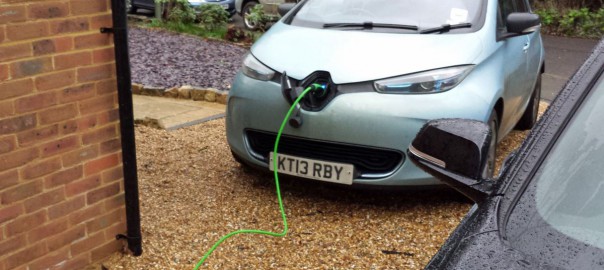Soon after I bought our Type 2 ‘granny’ cable I did some testing to see how long it would take to charge the ZOE (when set to 10 Amps, about 2.3kW). Previously I’ve done some detailed monitoring of charge curves, specifically for 7kW home charging and 43kW rapid charging. Given that I knew this method would take much longer than either of those I chose to not monitor the whole charge, instead just one hour to get an idea of its behaviour.

As before, at regular intervals I noted the percentage state of charge and the predicted time to complete; these are shown in Figure 1 and Figure 2 respectively. With such a short test it is difficult to draw any firm conclusions, but it appears to be safe to deduce:
- The ZOE dash predicts a charge time of about 10.5 hours from a start charge of 46%, so about 23 hours for a complete charge.
- The ZOE is actually charging at about 6% per hour, so it should reach full charge in about 16 hours.
These findings are not inconsistent with each other, and the charge time is probably about 17-18 hours. Firstly, the previous analyses of charging curves show that the predicted charge time decreases over time, so it will likely decrease towards an actual lower charge time. Secondly, the predicted time includes time for battery balancing where the simple linear charge estimation does not, in other words there’s probably an hour or two of balancing ‘charging’ when the charge curve hits 99% – hence the estimation of 17-18 hours.

Of course, it’s obvious that this is a very slow way to charge compared to 3.5 hours on the usual home charge point (or half an hour on a rapid charger). This may be partly due to the charger being a generic, non-ZOE specific one and it may be partly due to the ZOE being an older Q210 model which is well known for inefficient charging at low powers.
So, if any readers are keen to volunteer, it would be interesting to repeat the test on other setups, for example:
- A ZOE Dynamique Nav R240 with the Renault 13A cable
- A ZOE Dynamique Nav Rapid Q210 (or older Intens) with the Renault 13A cable
If anyone sends me the details I’ll post them.
Meanwhile, despite the slow speed of charging, I have made good use of the cable a number of times to grab a ‘top up’ while spending time visiting family.

Most recently it got used on Christmas Eve while visiting the in-laws during one of our regular trips to Oxford.

Then on Christmas Day we visited my brother’s family in Surrey for Christmas dinner, using a new route from Northampton down the A34. This meant using the Ecotricity charge point at the Reading M4 Eastbound services, which worked fine and took less than half an hour.

Returning back, having charged with the granny cable, we skipped using the Reading M4 Westbound services which turned out to be a mistake. The next one at Chieveley was down and we had to retrace our steps to Reading Eastbound – thus a timely reminder to always charge early and have a backup in mind in the direction you want to go.

Anyway, enough about rapid charging. I would recommend that any ZOE owner considers getting a granny cable for home charging. Although expensive they do give some peace of mind, particularly when public chargers can’t be relied on (which has been the case for us at least twice during Christmas holidays).

I have a new R240 and the official granny cable from Renault. Having used it two or three times now in the past week since the car turned up, and taken some notes, it’s charging at about 8% per hour, or put another way, about 6.5 miles range per hour. The external temperature has been about 6-8 degrees on each occasion.